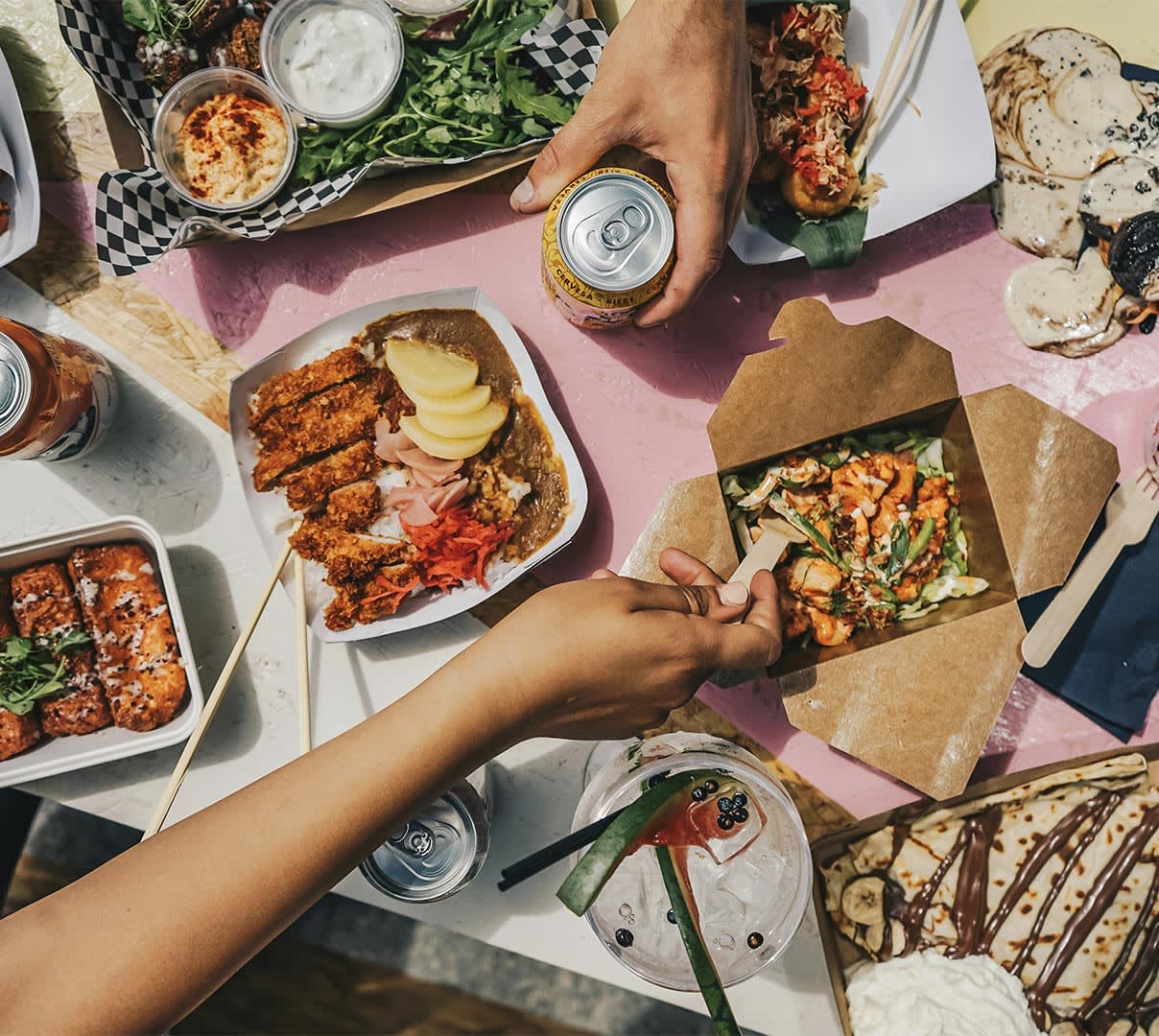The prevalence and importance of delivery continues to rise — the online food delivery market alone is expected to reach $1.22 trillion in 2024. For businesses like restaurants, grocery stores, and florists, it’s vital to understand how partnering with third-party delivery services could potentially reduce costs and streamline efficiency.

What is a third-party delivery service?
A third-party delivery service provides a comprehensive external platform that handles end-to-end processes and provides the technological tools to facilitate your online orders. Startup costs are low, implementation is fast, and the biggest challenges are handled by a team of specialists — from maintaining a delivery fleet to managing online ordering, payment, communications, and tracking technology.
On the front end, the service generally has their own website and mobile app where your business will be featured as part of a broader online marketplace, enabling greater exposure. On the back end, a third-party delivery service processes orders, coordinates pickup and drop-off, and tracks deliveries. Merchants pay a fee for these services, normally deducted from a portion of sales.
This saves businesses from the costs of trying to build and run a sophisticated online ordering operation on their own, which is why this model has become widely adopted.

"We realized that delivery wasn't something we wanted to manage ourselves. We can't focus on making the best pizza if we're worrying about how to get it to someone's house."
Why is third-party delivery important?
The popularity and prevalence of third-party delivery services is due in part to their astonishing sophistication. Smartphones, software integrations, POS management systems, and GPS technologies have all seen remarkable improvements since the first third-party delivery services arrived on the market decades ago.
And demand for seamless online ordering is burgeoning, as noted in a Deloitte report on the future of restaurants. Frictionless digital experiences and the desire for convenience, are driving consumer demand, and off-premises dining will continue to power growth across the food sector.
Analysts expect to see a compound annual growth rate of more than 10% by 2028 in the online food delivery market, and DoorDash research reveals that 70% of consumers surveyed reported that they had ordered food delivery in the past month, with a third placing more orders this year compared to last year.
Capitalizing on this demand and growth is a major consideration for restaurateurs, but every situation is unique, and ultimately you need to decide whether a third-party delivery service makes sense for your business. Is there enough demand for delivery services where you're located, and do the costs align with your operating budget?
These services may be a cost-effective way to offer delivery if that's the right strategy for your restaurant, but they're not free — commission fees can be a challenge for some businesses to navigate, depending on their cost structures and profit margins. Others may have hesitations about entrusting their customer experience to parties outside their direct control. Partnering with the right third-party service can help substantially mitigate these issues.

How do third-party delivery services operate?
Third-party delivery services have a front end for engaging customers and a backend for merchants. When you partner with a third-party delivery service, you upload and optimize your restaurant menu for potential customers to peruse for online ordering.
Once a customer places an order from their phone or computer, the third-party app routes the order to a tablet (often provided by the third-party delivery service) or your in-house POS system, which can be integrated with the third-party delivery services platform. The order includes the customer's name, order items, and special instructions or requests, along with any other relevant details. Then your team can accept the order, set an estimated delivery time, and start preparing the food.
Importantly, you don't actually have to process the payments — that's all done through the third-party service, and in most cases, the restaurant will receive their share of the profits in a weekly payout.
After the order has been relayed to your restaurant, the app locates and notifies a nearby delivery driver, who accepts the order. Following the directions in their app, the driver comes to your store when the order is ready, collects the order, and then delivers it to the customer. During this entire process, the app keeps the customer informed on the status of their order, pre-empting the need for them to contact your business with questions. When the delivery is complete, some platforms have a valuable verification feature that notifies the restaurant when the customer has received their order.
Incorporating third-party delivery services into your operating model means introducing new processes to your business, and it's important to train your staff accordingly. Make sure they know how to accept and process orders and package food for takeout, including having proper storage and containers to keep meals at the ideal temperature and texture.
Coordinating smooth hand-offs with delivery drivers is also necessary, and you may want to consider a dedicated pickup area in your restaurant for online orders.
Choosing a third-party delivery service
When selecting a third-party delivery partner, consider their market presence, reliability, and technological integration capabilities. It’s also important to ensure the platform offers robust customer support and transparent fee structures.
Beyond those initial steps and understanding the terms of agreement, here are some other factors when considering third-party delivery services.
1. Are the available integrations compatible with your technology systems?
If you already have a POS system and management tools, how will the third-party delivery service work with them to create new efficiencies for your business? Or, if you don't have a pre-existing POS system or don't want to integrate them, are there alternative methods for you to receive orders — for example, through hardware or software provided by the third-party delivery service?
These are questions to ask the delivery service's technical team as you evaluate their solution. Learn about their onboarding process so you know how easy or difficult it will be to synchronize your business tools with theirs.
2. Do you have flexible options for how to run your delivery business?
Third-party platforms can provide you with multiple possibilities to operate food delivery for your restaurant. If you prefer to offer delivery ordering via your own website, will they help you? What if you have most of the delivery infrastructure you need, and just need access to a fleet of on-demand delivery drivers? Third-party delivery services that truly lead the industry provide their merchant partners with multiple methods for facilitating online delivery so they can select the one that makes the most sense for their business model.
3. Can you access useful customer insights, data, and analytics?
There are some examples of third-party delivery services that restrict access to the customer data and insights that would allow restaurants to optimize marketing initiatives, loyalty campaigns, and special offers, as well as building relationships with repeat customers. Prioritize a third-party platform where you can actually track customer sales, trends, preferences, and patterns. Some delivery services also have tools to create promotions and loyalty programs directly in the app.
The benefits of third-party delivery
Third-party delivery isn’t just allowing you to meet the needs of offsite customers. It’s also driving incremental sales and profits, since these online orders are happening in addition to the orders you’re already fulfilling for dine-in patrons, and therefore don't add to the fixed costs of your normal operations.
You also have the opportunity to reach so many more customers and drive increased brand awareness. More than two-thirds of customers surveyed by DoorDash recently ordered from a new business on the app. A third-party delivery service is essentially an extension of your marketing efforts — even before you leverage in-app promotions to drive more sales. Third-party delivery also offers a competitive advantage, helping you differentiate your brand and broaden your customer base to reach people who use these popular delivery apps but may not have tried your restaurant.
Customers also want to be able to easily place online orders and track deliveries in real time. A specialized platform provides this convenience for them, since it would be prohibitively costly for restaurants to build this functionality in-house.

"The advantages of third-party delivery are obvious. We avoid headaches and can have capacity for lots of drivers depending on the volume of orders… On top of just having access to drivers and not having to manage it yourself, third-party delivery platforms can bring you business."
Third-party delivery services also provide convenience for restaurants by streamlining and automating orders — you don't have to worry about creating and maintaining expensive or complex delivery infrastructure, or stress over coordinating and managing drivers and logistics.
Partnering with a third-party delivery service like DoorDash can transform your business operations and drive significant growth. Learn more about how DoorDash can work for your business.





